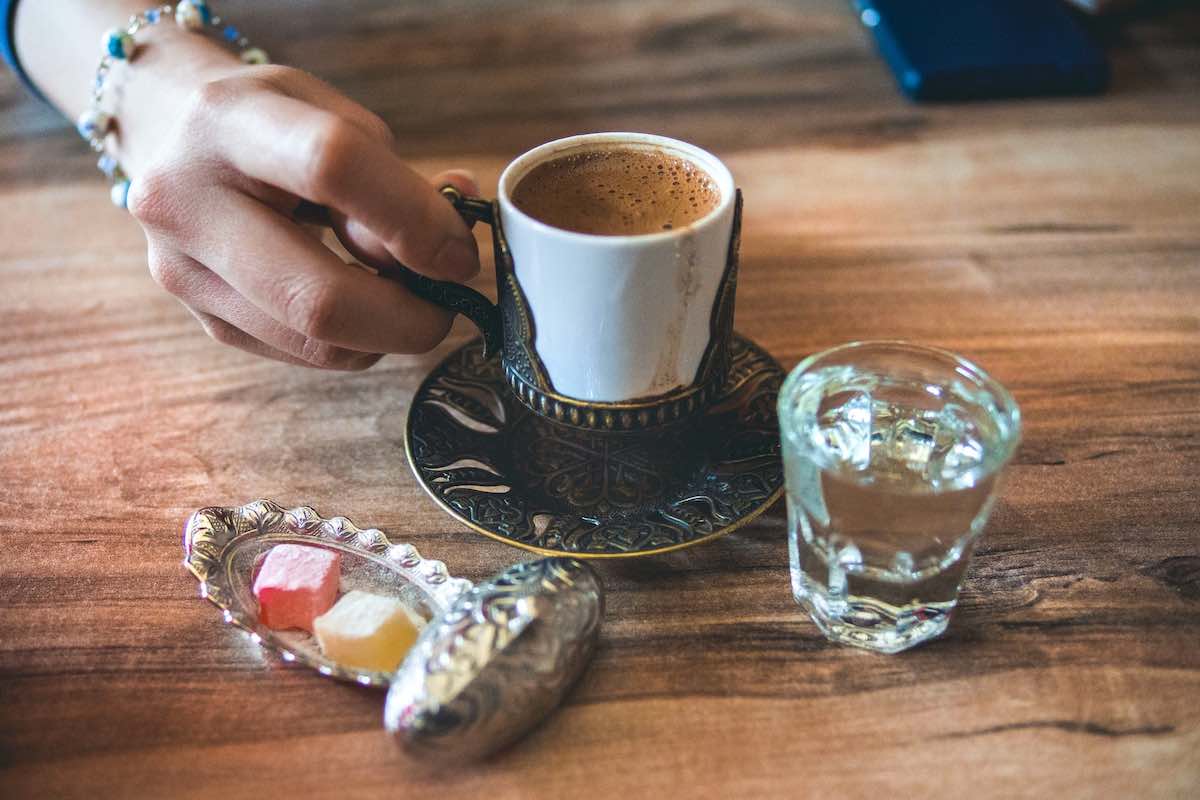The Middle East could be said to be the cradle of coffee. The first coffee beans come from here; the earliest coffee drinkers are Middle Easterners. Here, Arabic and Turkish coffee reign supreme. However, how similar and different are they?
Arabic and Turkish coffee are similar in that they use arabica beans. The coffee is also finely ground before preparation. These coffees can be different in roasting, preparation, use of spices, and serving style. You also enjoy the coffee with different types of tidbits.
In this article, let’s explore Arabic and Turkish coffee. We will first look at how similar they are before talking about their differences.
How Similar Are Turkish And Arabic Coffee?
Turkish and Arabic coffee comes from the Middle East, meaning they have some similarities here and there.
Coffee Beans
Generally, both Turkish and Arabic coffee is made using Arabica beans. There are usually no Robusta beans present.
This may be because of where Arabica beans come from, the Ethiopian highlands. The Arabian peninsula is much closer to this region, which would explain the preference for Arabica and not Robusta means.
Drank In Small Servings
When you look at how we drink coffee in America, we like our coffee served in large servings, such as in a mug. Then we sip on them slowly.
Not with Turkish and Arabic coffee. Both styles of coffee are drunk in small servings, usually in cups slightly larger than your espresso cups. This may be because both Turkish and Arabic coffee is intense and strong.
Unfiltered
In most cases, we tend to enjoy drinking our coffee clean. This means we do not want coffee grounds floating around as we sip our joe.
With Turkish and Arabic coffee, the coffee grounds are unfiltered and are left inside the coffee. The understanding is that the ground will keep the coffee strong and intense.
The coffee ground also sinks to the bottom of the cup. This means you can sip the coffee slowly without having coffee grounds in your mouth.
In fact, with Turkish coffee, there is a culture of fortune telling by looking at how the coffee grounds look after you finish your cup. More on this later.
Turkish vs. Arabic Coffee
Turkish and Arabic Coffee can be different in many ways, especially in the preparation and how it is enjoyed.
| Aspects | Arabic Coffee | Turkish Coffee |
|---|---|---|
| Popular In | Arab World | Old Ottoman Empire and parts of the Arab World |
| Roasting | Light | Dark |
| Preparation | Boiled in special coffee pots called Dalla | Boiled repeatedly in an open pot called Cezve |
| Spices | Cardamom, saffron, cloves | Cardamom, salep, mastic |
| Serving | Small cups with no ears | Small cups with ears and saucers |
| Tidbits | Dates, Knafeh | Turkish Delights, Baklava |
| Unique practice | Hand gestures when drinking coffee | Fortune telling |
Popularity
Generally, Arabic and Turkish coffee are drunk interchangeably. For example, it is common to see Turkish coffee being served in Arabic restaurants. Turkish kebab shops sell Arabic coffee too.
However, Turkish coffee is seen to have a wider appeal. You may be able to find Turkish coffee drinks in places where the Ottoman Empire once were, such as the Balkans.
In fact, the Levantine Arabs (e.g., Syria, Lebanon) may also drink coffee in a style closer to Turkish rather than Arabic. Arabs in northern Africa may also drink Turkish rather than Arabian coffee.
Arabic coffee may have a more limited appeal. Traditional Arabic coffee tends to be more popular in the Arabian peninsula and the Gulf region.
Roasting
In general, Turkish coffee beans are roasted dark for full flavor. With Arabic coffee, the preference is to roast lightly.
The difference in roasting may also show up in the coffee itself. Suppose you are served Arabian coffee in Kuwait or Jeddah. You may see a lighter, clearer coffee. The color may be closer to brown than black.
The opposite applies to Turkish coffee. It is dark and looks like it will deliver you a punch in the face.
However, there will be places where you may be served Arabic coffee with dark roasted beans, especially in the Levant or North Africa.
Preparation
Arabic and Turkish coffee is prepared quite differently, which may explain how they are served too.
Traditionally, both Arabic and Turkish coffee were made by roasting, and then pounding the beans into fine powders. However, grinders are also popular today, since they are easier to use.
Arabic coffee is commonly prepared by boiling water and coffee grounds inside a Dalla. The Dalla is usually an ornate kettle, which also functions as a teapot. Dalla tends to be tall and slim and has a long, slim, and open spout that helps pour the coffee into a small cup.
Turkish coffee has a more complicated preparation process. Coffee grounds in water are mixed in a Cezve pot. Cezve pots are small and have a long handle and a small pouring lip. Cezve pots are also called Ibrik by some.
As the water and coffee mixture boils, the maker takes the pot off the fire and pours it into a small cup. The boiling and pouring process repeats several times until the cup is full and ready for serving.
Spices
Arabic coffee may be prepared with some spices mixed inside. Common spices include cardamom, cloves, and saffron.
Saffron is a very expensive spice, which means you only see them in expensive restaurants. If your host is wealthy, he may also serve you Arabic coffee with saffron.
Turkish coffee is usually served without spices added in. However, some drinkers prefer their coffee with cardamom too. Other spices, such as Mastic and Salep, are also used with Turkish coffee.
Serving
Arabic coffee is usually drunk as a communal, social activity. The idea is to serve a small serving of coffee from a large pot and chit-chat as you sip on them.
As a result, Arabic coffee is usually served in small cups called Fenjan. These cups are usually made of ceramic and do not have ears. The shape may remind you of Chinese tea cups.
Arabic coffee is also commonly not served with a saucer. You are expected to hold on to the cup with your hand as you sip it.
Turkish coffee is also drunk as a social activity but may be enjoyed alone. This is because Turkish coffee is served directly in a cup instead of poured from a pot.
Turkish coffee cups are called Kahve Fincani. Shape and size-wise, they may look like your espresso cup but slightly larger. The cup also has ears, and it is common to have your Turkish coffee served with a saucer and a spoon.
Kahve Fincani also can be simple or incredibly ornate. Luxurious ones may even have gold platings, with very detailed carvings and paintings.
Tidbits
Turkish and Arabic coffee are commonly enjoyed with sweet tidbits to help remove their bitterness. The differences may be in the type of snacks served with each coffee.
With Arabic coffee, the most common tidbit would be dates. These dates are very sweet and complement bitter coffee well.
If drank as an after-meal drink, you may see your Arabic coffee served with desserts such as Knafeh. Knafeh is made of spun pastry and cheese and topped with syrup and nuts.
Turkish coffee may instead be served with sweet treats such as Baklava or Turkish delights.
Baklava is made of filo pastry, with chopped nuts as fillings. They are then soaked in syrup and then cut into cubes. Turkish delights are basically colorful starch gel cubes with powdered sugar.
Unique Practice
Traditional Arabic coffee drinking can be an elaborate social ritual full of non-verbal communication.
A typical session may start with a group sitting around in a circle. The server may start to make coffee by grinding the coffee beans, adding the grounds into the Dalla, and boiling it over the fire.
Once the coffee is ready, the server may take several Fenjan cups, stack them together, and stack clinking them. This signals to the others that the coffee is ready.
The server then hands the cups out and starts pouring. Elders get their coffee first or the special guest in the session.
As people chat and sip away, the server will continue to pour into the cups. You indicate that you no longer want coffee by tilting the cup left and right several times.
You always hold your coffee cup, and when receiving a pour from the server, you always use your right hand.
Turkish coffee may not have the elaborate practice as Arabic coffee, but it does have something very special. It is common to engage in fortune-telling after drinking your Turkish coffee.
This usually works by having you think about things you would like your fortune told, such as business, or relationships. You do this as you drink your Turkish coffee.
When you finish, someone with the knowledge looks at the leftover coffee grounds. The patterns, shapes, and positions may reveal something about your fortune.
Wrapping Up
Arabic and Turkish coffee may differ in many ways, including preparation, serving, and flavor. However, both are excellent styles of coffee that may give you something new to experiment with.
Ultimately, choosing between Arabic and Turkish coffee may be up to you. Try out some yourself, and decide which is your favorite! On another note, if you have been wondering how different Cappuccino and Espresso are from each other, check out our guide.
Frequently Asked Questions about Arabic Coffee vs Turkish Coffee
The main differences between Arabic and Turkish coffee lie in their roasting, preparation, spices, serving style, and unique practices. Arabic coffee is often lightly roasted and boiled in a Dalla, while Turkish coffee is darkly roasted and prepared in a Cezve pot.
Both Arabic and Turkish coffee traditionally use Arabica beans, which are also commonly used for regular coffee. You can use regular coffee beans, but ensure they are finely ground before preparing the coffee according to the specific method for either Arabic or Turkish coffee.
The coffee grounds in both Turkish and Arabic coffee settle at the bottom of the cup. When sipping the coffee, drink slowly and avoid the last sip to ensure the grounds stay at the bottom and don’t end up in your mouth.

I’m Joel, an espresso-loving coffee nerd. I got into coffee because I spent a lot of time in Milan as a kid and started liking coffee waaaay too young. I’m all about making sure espresso is treated with the same care as any other coffee – it’s not just a quick drink!


Leave a Reply